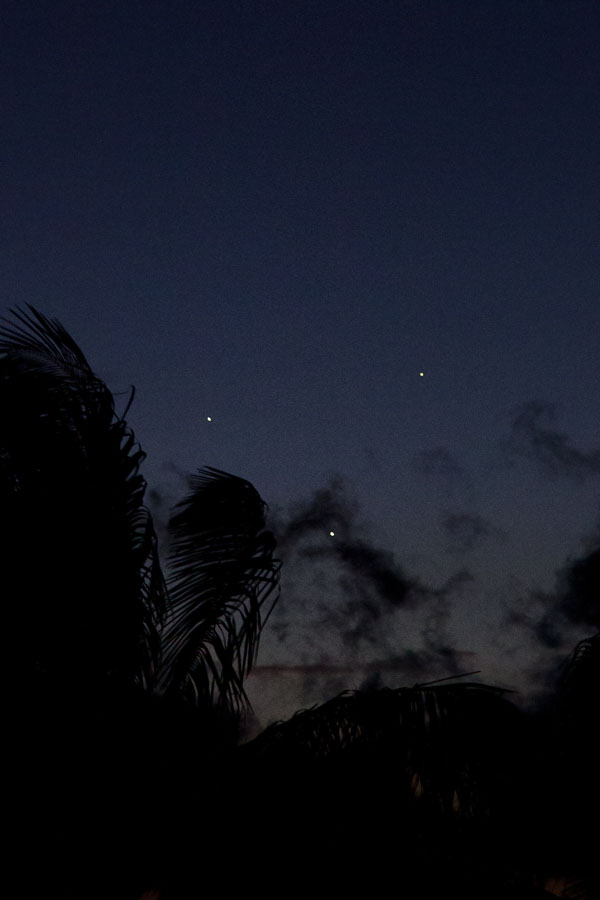
Author: Andrew
Downpour
It looks like it may clear. There should be a few dark hours before moonrise. Maybe I can get the new astrophoto rig out and get everything working properly.
<Commence tropical downpour>
Nothing like two tenths of an inch of rain in half an hour to put a damper on astronomical plans.
Maybe it will clear later.
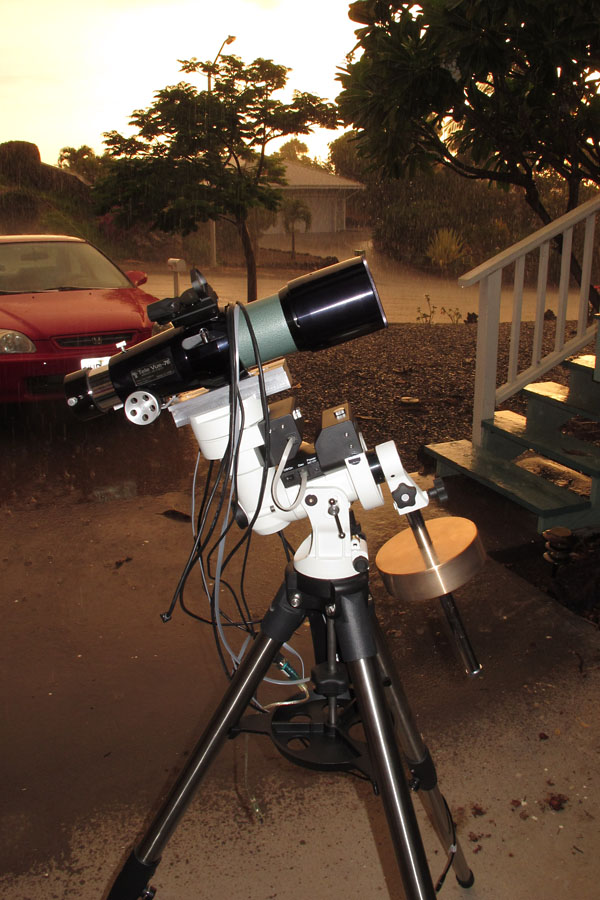
Asteroid 2008 QE2 Ephemeris
Planning to make a go at photographing asteroid 2008 QE2 as it passes the Earth. Before I can do that a little planning is in order. Minor questions… Is it above the horizon near close approach, in my nighttime sky? It turns out this object will be available for observation.
The table below is a precision ephemeris generated by the NASA HORIZONS web interface for Mauna Kea on the island of Hawai’i. Listed are celestial coordinates, time, local elevation and azimuth, magnitude and distance. The marks after the time column indicate daylight (*), twilight (A) and moonlight (M).
From the data it is clear that the evening of May 30th (May 31st UT) allows observation from Hawai’i, at an elevation of ~46° a few hours after dark. Nicely placed and nicely timed for observation. Close approach is actually the next day, but the difference is minor. The next evening allows a second chance at the observation while the asteroid is still close.
|
1 2 3 4 5 6 7 8 9 10 11 12 13 14 15 16 17 18 19 20 21 22 23 24 25 26 27 28 29 30 31 32 33 34 35 36 37 |
Date Time(UT) RA Dec Az El Mag Dist(AU) 2013-May-30 00:00 * 13 43 52.20 -28 33 56.2 112.3 -29.8 11.21 0.04085 2013-May-30 02:00 * 13 46 41.34 -28 16 36.7 118.4 -4.7 11.18 0.04069 2013-May-30 04:00 * 13 49 26.76 -27 58 53.8 130.2 18.3 11.16 0.04054 2013-May-30 06:00 A 13 52 09.08 -27 40 36.2 151.4 36.2 11.14 0.04040 2013-May-30 08:00 13 54 49.78 -27 21 36.2 184.3 42.6 11.12 0.04027 2013-May-30 10:00 m 13 57 30.80 -27 01 52.3 215.4 33.2 11.10 0.04016 2013-May-30 12:00 m 14 00 14.01 -26 41 29.3 234.5 13.6 11.08 0.04006 2013-May-30 14:00 m 14 03 00.70 -26 20 37.2 245.4 -10.2 11.06 0.03998 2013-May-30 16:00 *m 14 05 51.26 -25 59 28.2 251.6 -35.9 11.04 0.03989 2013-May-30 18:00 *m 14 08 45.07 -25 38 14.0 252.2 -62.2 11.02 0.03981 2013-May-30 20:00 *m 14 11 40.61 -25 17 03.0 180.9 -84.4 11.00 0.03973 2013-May-30 22:00 * 14 14 35.91 -24 55 57.7 106.2 -62.5 10.98 0.03965 2013-May-31 00:00 * 14 17 28.96 -24 34 55.0 106.6 -35.9 10.96 0.03956 2013-May-31 02:00 * 14 20 18.30 -24 13 47.1 112.4 -9.7 10.94 0.03948 2013-May-31 04:00 * 14 23 03.30 -23 52 23.2 122.8 14.9 10.92 0.03940 2013-May-31 06:00 A 14 25 44.36 -23 30 33.2 141.7 35.8 10.90 0.03933 <strong>2013-May-31 08:00 14 28 22.79 -23 08 10.0 174.9 46.8 10.89 0.03928</strong> <strong>2013-May-31 10:00 14 31 00.46 -22 45 11.5 211.6 40.5 10.87 0.03924</strong> 2013-May-31 12:00 m 14 33 39.26 -22 21 41.4 234.6 21.6 10.86 0.03922 2013-May-31 14:00 m 14 36 20.68 -21 57 48.0 247.4 -2.4 10.84 0.03921 2013-May-31 16:00 *m 14 39 05.32 -21 33 42.1 255.5 -28.6 10.83 0.03921 2013-May-31 18:00 *m 14 41 52.80 -21 09 34.6 261.1 -55.6 10.81 0.03921 2013-May-31 20:00 *m 14 44 41.82 -20 45 33.3 260.5 -83.0 10.80 0.03921 2013-May-31 22:00 *m 14 47 30.51 -20 21 41.7 95.4 -69.3 10.78 0.03921 2013-Jun-01 00:00 * 14 50 16.87 -19 57 58.3 99.5 -41.8 10.77 0.03921 2013-Jun-01 02:00 * 14 52 59.31 -19 34 17.3 105.9 -14.8 10.75 0.03920 2013-Jun-01 04:00 * 14 55 37.04 -19 10 30.4 115.3 11.2 10.74 0.03920 2013-Jun-01 06:00 A 14 58 10.22 -18 46 29.3 131.8 34.7 10.73 0.03921 <strong>2013-Jun-01 08:00 15 00 39.97 -18 22 08.0 163.7 50.2 10.72 0.03924</strong> <strong>2013-Jun-01 10:00 15 03 08.03 -17 57 24.4 206.9 47.9 10.71 0.03928</strong> 2013-Jun-01 12:00 m 15 05 36.32 -17 32 20.9 234.7 29.7 10.70 0.03934 2013-Jun-01 14:00 m 15 08 06.41 -17 07 04.2 249.5 5.3 10.69 0.03941 2013-Jun-01 16:00 *m 15 10 39.11 -16 41 42.7 259.1 -21.1 10.69 0.03949 2013-Jun-01 18:00 *m 15 13 14.27 -16 16 25.3 267.5 -48.5 10.68 0.03957 2013-Jun-01 20:00 *m 15 15 50.83 -15 51 18.8 283.9 -75.9 10.67 0.03966 2013-Jun-01 22:00 *m 15 18 27.08 -15 26 26.5 75.8 -74.8 10.67 0.03974 |
Mercury, Venus and Jupiter
The evening dance of Mercury, Venus and Jupiter continues. This evening will see Jupiter and Venus draw to within 1°09′ of each other. Tomorrow will see the configuration shift a bit, Jupiter and Venus slightly closer at 1°05′ separation. Mercury will be about 3° above the close pair.
With Venus rising a little each day while Jupiter is heading into the sunset and superior conjunction, the pair will quickly separate after this close approach. After the end of the month Jupiter will depart the stage.
Planetary Conjunction
Puakō Night Dive
Watching sunset is one way to end the day, in this case it heralded the start of our activity. We were waiting for the Sun to go away, for the skies to grow dark. We were preparing for a night dive.
Once again into the black water, looking to meet the the reef’s night shift. It would be our usual crew… Pete, Sky, Mark and myself for the dive. Dennis joined for dinner, but did not stay for the dive.

While I had never used this particular entry, we were all familiar with the Puakō reef, having dove the area many times over the years. The layout is pretty straightforward. A shallow reef slopes away from shore for about 50-100yards, reaching about 10ft deep. There you will find ancient sea cliffs, a sheer rock wall that drops to 25′ or 35′ depth. Below this wall the reef slopes away, sometimes gently, sometimes steeply. At 70-100ft you reach sand that slopes further into the abyss. Our goal would be the old cliffs. These are pockmarked with small caves and overhangs, excellent terrain to explore on a night dive, there should be plenty of small invertebrates about.
The plan was simple, taking advantage to the nature of the Puakō reef and the multiple entries available along the shoreline. We would enter at one point, do a one way dive along the submerged seacliffs at 20-30ft, then exit at another entry about a quarter mile further south. Exit would be aided by a strobe left at the designated exit point, a bright light in flash mode easily visible to lead us back to the correct landfall.
Overhead a full Moon rose, lighting the sky and aiding our visibility. Once under water the moonlight would ad another dimension to the dive. The glow of moonlight coming through the water was sometimes quite pretty.
At one point I did something I almost never do on a Hawaiian reef. I was actually forced to use my compass for navigation. Normally the slope of the reef quickly indicates which way is shore. I had followed Mark out onto the reef below the wall. After a little photography I found myself disoriented, which was was the shore? I held my compass to the divelight to charge the glow-in-the-dark dial, then got my bearings to head back to the wall. I know I bought the console with a compass for some reason. Just a reminder of how easy it is to lose ones bearings in the dark water.
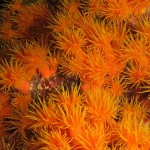
The strobe worked very well, we were able to head inshore, across the reef shallows, to just the right point. The shallows at Puakō can be a nuisance to cross in the day, they are more so at night. There was no real surf to complicate the issue, but you are just feeling your way across the rocks. I only put my hand on one urchin.
It was a pretty stroll back to the house along Puakō Road. A warm tropical night, a bright full Moon high overhead. We were chatting about the dive, reveling in the experience. One car did pass us as we walked, it must have been an interesting sight… A group of four guys in full scuba gear, dripping wet, walking down the center of the road.
Back at Pete’s place we broke out snacks and drinks. Beer and scotch appeared, dive photos reviewed, as we talked story for hours. Yeah, it was that sort of night.
Mercury, Venus and Jupiter
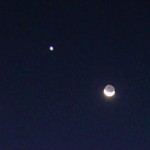
While Jupiter will leave the stage, exiting into the sunset after the end of the month, Mercury and Venus will continue the dance well into June.
Full Moon
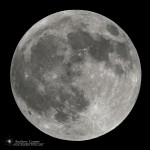
A penumbral lunar eclipse will occur, but it is so minor there is little point in trying to observe it. As the NASA eclipse site notes… “With a penumbral eclipse magnitude [6] of 0.0158, just 0.5 arc-minutes of the Moon’s southern limb will pass into Earth’s pale penumbral shadow; such a shallow eclipse is only of academic interest since it will be all but impossible to detect.”
Mega-galaxy is Missing Link in History of Cosmos
W. M. Keck Observatory press release…
Two hungry young galaxies that collided 11 billion years ago are rapidly forming a massive galaxy about 10 times the size of the Milky Way, according to UC Irvine-led research conducted on the W. M. Keck Observatory and other research facilities around the world. The results will be published today in the journal Nature.

HXMM01 is fading away as fast as it forms, a victim of its own cataclysmic birth. As the two parent galaxies smashed together, they gobbled up huge amounts of hydrogen, emptying that corner of the universe of the star-making gas.
“These galaxies entered a feeding frenzy that would quickly exhaust the food supply in the following hundreds of million years and lead to the new galaxy’s slow starvation for the rest of its life,” said lead author Hai Fu, a UC Irvine postdoctoral scholar.
The discovery solves a riddle in understanding how giant elliptical galaxies developed quickly in the early universe and why they stopped producing stars soon after. Other astronomers have theorized that giant black holes in the heart of the galaxies blew strong winds that expelled the gas. But cosmologist Asantha Cooray, the UC Irvine team’s leader, said that they and colleagues across the globe found definitive proof that cosmic mergers and the resulting highly efficient consumption of gas for stars are causing the quick burnout.
Continue reading “Mega-galaxy is Missing Link in History of Cosmos”
Going Snorkeling
Normally I do not snorkel around the reef, rather I prefer donning full kit including tank and regulator allowing a more immersive experience. Staying down allows me a freedom of movement, to explore well beyond the twenty five feet or so that I can reach without the gear. Scuba permits me to carry a camera with time to compose a subject and observe behavior.

I skim along, the large fins providing effortless speed. The view is different than that of scuba, you are always looking down. I stay in the shallower water where the coral comes close to the surface. On occasion I dip down below the surface to get a closer look, weaving through the coral on long shallow dives. To go up I simply stop swimming to allow my buoyancy to lift me to the surface. A sharp breath clears the snorkel of water. With practice the actions are almost reflex, as natural as breathing on shore.
There are species that prefer the shallows, rarely seen when diving, often common in just a few feet of water. Snowflake morays, the colorful lagoon triggerfish, snorkeling allows spotting of a different reef community. I often make a point to sweep the areas just off the shore in three feet of water or less, just to see what can be found.

